September 9, 2015, 12:56
Relationship fine motor skills and mental activity.
The formation of the child's verbal speech begins when the movements of the fingers reach sufficient accuracy. It has been established that in the human brain the centers responsible for speech and finger movements are located close, so speech reactions are directly dependent on the fitness of the fingers.
Terms effective development fine motor skills.
Motivation is the ability nervous system to control muscle contraction, which leads to a definition of a process leading to the development of precise motor programs, with increasingly adequate control and coordination functions with growth, which do not belong to a single brain area, but rather systems connections that gradually mature, at least until adolescence.
This is due to the presence general programs engines that are associated with the need to adapt to the context, with integration with the sensory and perceptual information that comes from it. This adjustment process uses proactive mechanisms whereby the subject assumes the adaptation of the engine model to the characteristics or environmental requirements, which provide information about the performance of the action and make corrections in case of error.
All fingers of both hands must be used. Compression, stretching and relaxation movements must be combined. Exercises should be based on the use of isolated movements of each finger. For the successful development of fine motor skills, it is important to train both hands. It is important in games to equally develop subtle movements of the fingers of both hands, and in everyday life to strive to distribute various actions between the right and left hands.
The child must follow three functional processes in the hierarchical position: coordination, the process of stimulation diffusion inhibition and somatic integration, in addition to the absence of neurological damage. Coordination is defined as the first organizational process of motor action for the correct spatial direction of intentional movement. Motor coordination is based on timely adjustment in terms of strength and duration of contraction of the agonist and synergistic muscle groups, relaxation of the antagonist muscles and balance regulation, as well as the correct processing and integration of sensory information coming from the environment.
The value of games for the development of fine motor skills.
Games and exercises for the development of fine motor skills are a powerful means of maintaining the tone and performance of the cerebral cortex, a means of interacting with the underlying structures. In their process, children improve attention, memory, auditory and visual perception, perseverance is brought up, playing and educational and practical activities are formed. Systematic exercises also help to develop the skills of self-control and self-regulation of hand movements not only under visual control, but also with the participation of touch, tactile-motor sensations.
The child at the stage of learning this motor pattern repeats it several times, even in subsequent days, until he gets a result that is considered optimal according to his desire. At this stage of training, it is especially important to organize feedback with information about the individual moments of the engine that make up the act. Initially, the action is unsafe, poorly organized in a spatio-spatial sense, now with slow moments, now with sharp and directed difficulties, but frequent repetition of tests improves the result and allows you to study the engine model.
Games that parents can make from scrap materials.
To strengthen and develop the child's hand, coordination of movements, various exercises and actions with objects are recommended:
1. Twisting tapes.
2. Lacing. You will need a piece of linoleum with holes made and a lace. (game "Lacing").

Accuracy and control also affect their evolution of environmental characteristics in a broad sense, in the sense of an experimental component. Motor organization includes the organization of movement realized with the help of a plan and with a purpose and an appropriate context. The organization of various aspects of motor skills supports coordination, including muscle tone, movement fluidity, motor planning, and motor control. Muscle tone and fluidity of movement affect both body confidence and ease of movement in the environment.
You can also find at home some object that is not heavy, on which there will be many holes.
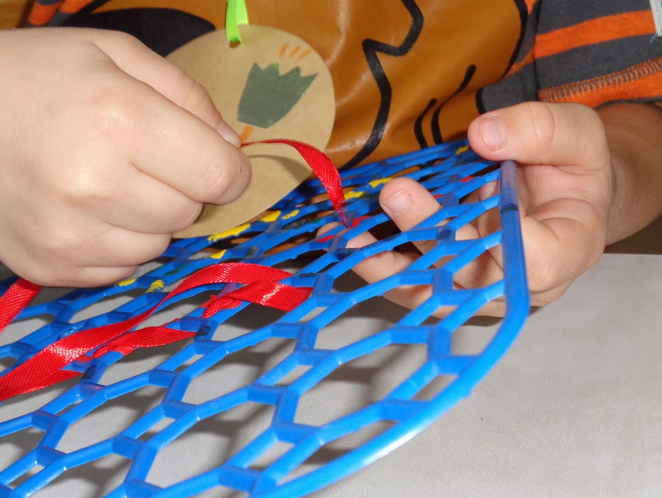
Another option..
You will need:
As a basis, you can take any dense, non-flowing material, such as felt, fleece, and best of all, foamed polymer of different colors. In a chemical store or in a supermarket, buy cleaning cloths.
Motor planning includes forecasting and the sequence of specific actions necessary for the implementation of activities. Engine control includes starting and final drives and modulating their intensity. Inhibition of the spread of the stimulus in other parts of the body is a process of long maturation on the evolutionary path, which is influenced by and environment, and personal characteristics of emotional sensitivity that are easily present even during adult life whenever new Physical activity never done before, such as the common tone of the child to early lessons to learn to write.
![]()
laces and limiters for laces;
buttons are large, preferably on the leg;
marker, pencil or pen;
scissors with pointed ends;
Lacing "Hedgehog"
Draw a hedgehog figure on the wrong side of the material and cut it out along the contour. On the front side, mark the nose, eye and mouth with a marker or felt-tip pen.
Therefore, in addition to the physiological evolutionary process, it is necessary to take into account the emotional level of the moment and personal emotional emotional-emotional characteristics. An adequate process of inhibition of the spread of the stimulus opens up the possibility of structuring the process of somatic integration.
Limiting the diffusion of stimulation is critical to synergize the motor with somatic parts that are not intentionally controlled; Synergy that can help improve the performance of a volunteer engine model. These schemes of help are called utility synergies and appear in the evolutionary course as it solves the constraint on stimulus propagation. The transplantation of various synergies is progressive in the evolutionary course and aims to achieve the best possible outcome.

From the same material, cut out a variety of fruits, mushrooms, leaves, which the child will lace up to the back of the hedgehog. If you also have a problem with the desired color scheme, use colored paper, glue it with PVA glue. Let the glue dry well, otherwise when you make holes, the paper may deform.
As for motor skills, we consider the development of these skills from the age of 3, considering them as functional motives for behavior in adaptive and social skills. The child learns ever more efficient motor strategies that are chosen as a result of favorable driving experiences. Inefficient engine sequences will be discarded in favor of those that are efficient.
In other words, we refer to the dust as an action consisting of functional procedures for adapting the subject to the context in accordance with the development of high-motor and final skills of motor coordination. In this chapter, we will look at the physiological development of a child between the ages of 3 and 6.

Lace is ready. Take a string, make a knot at one end or put on a stopper so that it does not slip through the hole, and show your child how to attach the fruits to the back of the hedgehog. At the same time, you can even come up with some kind of fairy tale, how the hedgehog collected fruits and mushrooms for lunch.
Simple kinematic coordinates
Between the ages of 3 and 6, the child has acquired good basic motor skills, especially in relation to simple organic coordinates, full-bodied, free body movements that do not require much muscular effort or specific adaptation to outer space. Them adaptive function is to navigate through space in order to reach a person, place, object, or to achieve pure kinesthetic pleasure.
Creeping rolling elephant. . At 3-4 years old, the child uses more and more races at a stationary station: he learns to run, brake, change direction, no longer bend his knees to collect an object and is able to walk in a straight line without losing his balance.
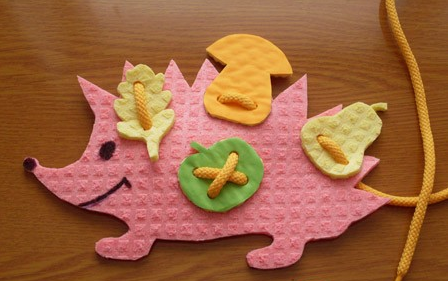
You can just take the figures and make more: boats, cars, butterflies, flowers, etc. you can buy bright laces and play with your child)))
Now we can invite the baby to sort the leaves by color. Remember to blow like the wind, mixing all the leaves. Turn on breathing exercises very helpful in class!
At this age, the child rarely performs simple coordination on demand, willingly taking part, imitating a partner or making it spontaneous. From 4 to 6 years old, the child improves the quality of motor coordinates, since now he owns all of them. It is able to change its speed, muscle energy and amplitude, depending on the environment in which it is located.
Complex kinetic coordinates
Now we are focusing on the description of complex model templates, which are purchased especially in age group 3-6 years and which are characteristics of life relationships and social contexts in which the child is constantly immersed. Complex kinetic coordinates are free body operations or the presence of an object that requires good dynamic balance and some muscle strength.
There is another great game: from which tree a leaf. We collect leaves of one type, for example, only maple.

If you have played enough with the leaves, then you don’t need to put them in the closet, they will perfectly decorate the house! We take the rope and string the leaves. For kids, the sequence can be any, and older children can be offered to string in a certain sequence. Following the sequence, the child trains not only fine motor skills, but also attention, memory, thinking. This is a great exercise to prepare for school.
Compared to simple coordinates, their adaptive function seems more playful, gymnastics. A typical motor voltage requires a certain "motor ambition" of the subjects and therefore more intentionality than the previous coordination.
We can find the beginning of Complex Coordination in the third year of life when the child tries to jump on foot and walk on his feet. Climbing and fast tracks Tricycle and bike jumping Skills. . By the age of 3 or 4, the child will switch to the well-known, more stable and safe cycling tricycle, but also slower and less controllable. In fact, a tricycle does not require a child to have the stability and balance required by a bicycle.
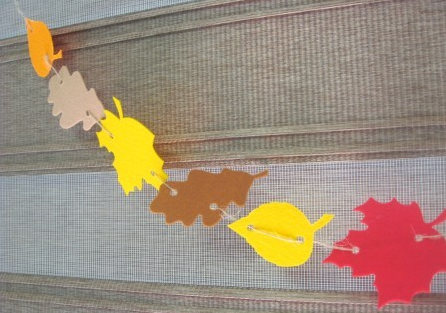
We make a tree trunk from felt, porous rubber or thick cardboard.

The beauty of such lacing is that the more randomly laced the leaves, the more magnificent and beautiful the tree. We accustom to order in such games gradually, a little training and it will turn out beautifully and evenly. Children will like the tree, here you can lace from the heart :) and no one will say that it is so wrong.
The tricycle is an important milestone and it is a fundamental premise because it conveys to the child all the principles that will serve him later to ride a bike well. These are the basic prerequisites. Acquisition of a pedal characterized by a sequence of motives in sequence: alternation of the lower limb pushing down and forward. Rudder control for direction change: Eyepiece-motor integration through simultaneous control of the upper limbs and vision. Pump more power to buy speeds: through modulation and tone control. Balance maintenance and good trunk management. . After about 4 years, the child can start using the bike: it allows you to explore large spaces and is the "winning of freedom" for the child.
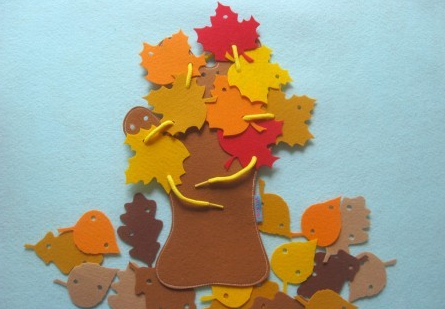
And the last version of the game for today is a wreath. Do I need to say how children love to decorate themselves and their mother, to give gifts? Such a wreath autumn leaves can become part of the autumn costume for a holiday in kindergarten. You can not limit yourself to a wreath, but make beads, a bracelet and even a ring from a tiny leaf.
After 4 years, the child begins to ride a bicycle equipped with side wheelchairs, they are necessary for the stability of the car and are fundamental, since the child still does not know how to maintain balance. When a child uses a bicycle with wheels, his "cycling activity" does not go far beyond the tricycle, as there is no need to process the balance of the vehicle and not take into account its stability under various driving conditions.
The predominant activity is still pedaling, braking and measuring space, distances and speed. It is extremely important to go through a bicycle with wheels to get from a tricycle to a regular bicycle, because before moving the wheelbases, it is obvious that the child had to master and control a larger vehicle different from the previous one.
We choose a lace or ribbon and collect the leaves. You can take several leaves at once to make the wreath richer.
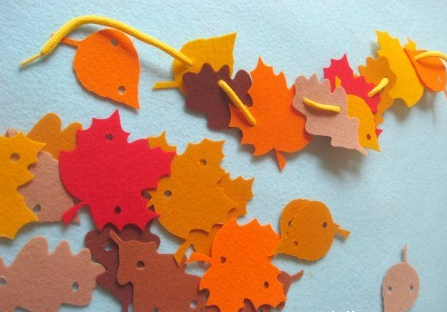

3. Button fastening. You will need fabric, buttons and thread. (game "Clutches").

After 5-6 years, the child can begin to remove the wheels and get the opportunity to ride bicycles. The bike seat should be positioned at a height so that it can allow the child to touch their toes on the ground and adopt a proper posture that is comfortable on the pedal.
Pedestrian crossing equals the onset of complex coordination and begins to be felt in a 3-year-old child, although the child spends a lot of time jumping over the next few years, especially between 4 and 6 years of age. Jumping in place is a global tonic-motor activity that requires some strength and sufficient balance, which is still developing at this age.
Zipper, Velcro, buttons, buttons...
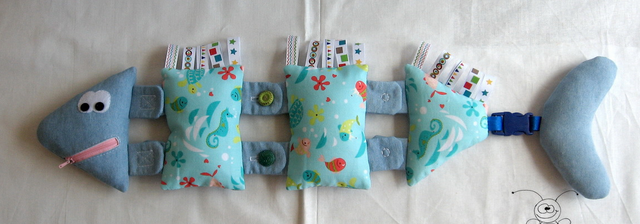
4. Laying out according to the pattern, sorting out the bones, cereals, multi-colored pebbles,
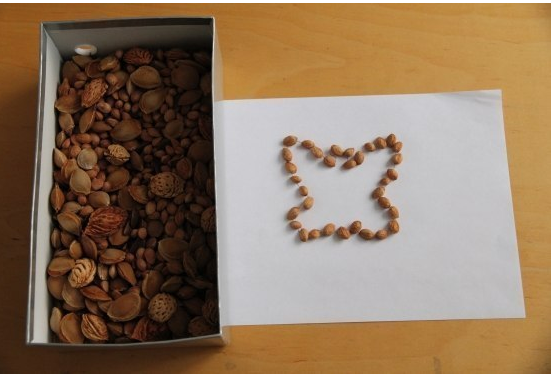
5. Games with clothespins. You will need clothespins and cardboard.
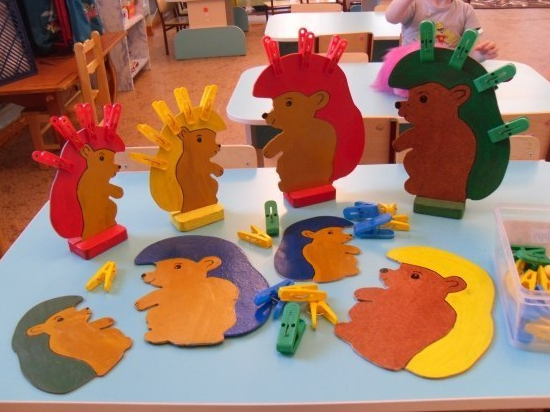
You should also consider the aspect of rhythm, because the repetition of the jump implies a regularity of activity over time. Jump to the place of ski jumping lifted ground jump obstacles with long jump. The jumping advance involves great hand-stem coordination with forward and backward transitions.
Initially, after 2 years, the child imitates coordination postures without leaving the ground, but only with the extension and raising of the legs on the legs. After 4 years, the strength and coordination of the children's toning motor is still not sufficiently developed, they all move one by one, jumping into place is very irregular, with little takeoff. He can make a jump over time by taking the lead.
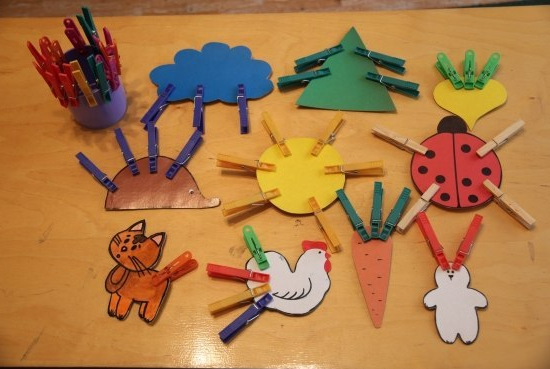
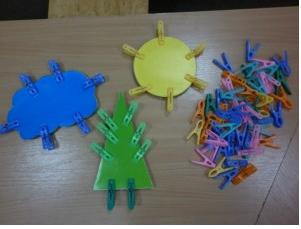
6. Unscrewing and tightening the covers. You will need necks and caps from plastic bottles, a shoe box, glue.
You can also use caps of different sizes and shapes, and with juice caps.
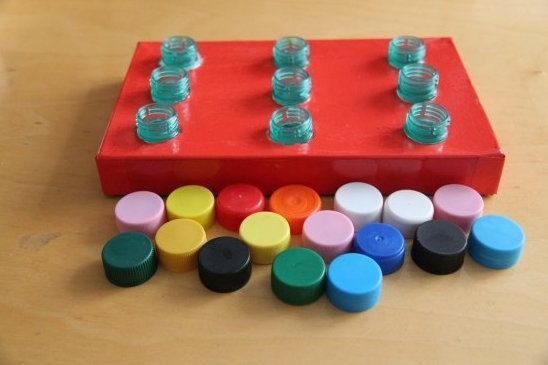
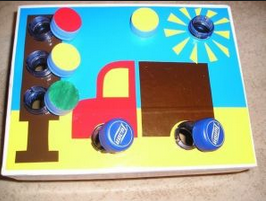
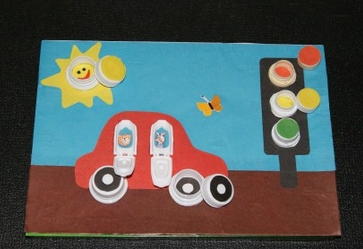
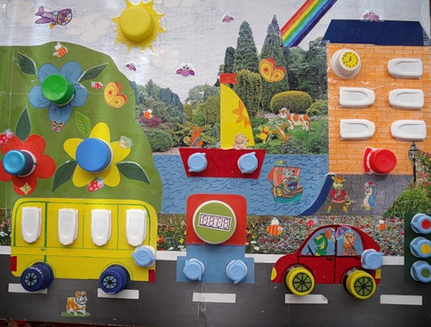

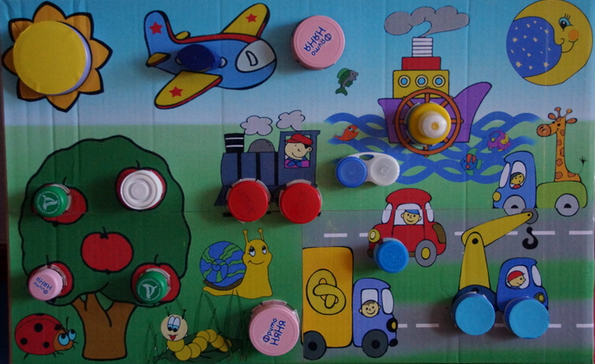
You can also use bolts and nuts of different sizes)

7. Guessing objects by touch. (Game "Magic bag"). You will need a bag with a variety of small toys and items.

8. Rolling a pencil or pen in the palms helps to stimulate biologically active points, toning the body as a whole.
 9. Stroke stencils. Would need plastic bottle with a flat wall (a shampoo bottle, scissors are suitable.
9. Stroke stencils. Would need plastic bottle with a flat wall (a shampoo bottle, scissors are suitable.
 Each of these techniques is aimed at the development of the child: his musculoskeletal system, sensory sensitivity, hand-eye coordination, voluntary attention, psychoregulation skills, develop fine motor skills of fingers through actions with objects; to form the ability to examine objects by touch; develop speed of thinking; cultivate perseverance
Each of these techniques is aimed at the development of the child: his musculoskeletal system, sensory sensitivity, hand-eye coordination, voluntary attention, psychoregulation skills, develop fine motor skills of fingers through actions with objects; to form the ability to examine objects by touch; develop speed of thinking; cultivate perseverance
Applications 2
Didactic games "Development of fine motor skills of hands"
"Pears and Apples with a Button"
Target: to exercise children in reinforcing the concepts of “big - small pear”, to teach how to fasten and unfasten pears, apples, where the child reinforces the concepts of “one”, “many”, the development of fine motor skills of hands.
Equipment: pictures of apples, pears, threads, buttons, cardboard for tree layout, adhesive tape for "lamination".
Game progress: Let's play "Hurricane" - blowing on a tree and swinging it with one hand, the teacher or child unfastens an apple from it. “Bang! The wind blew the apple away and it fell to the ground. They offer the child to be the wind - to blow, shake the tree, then unfasten the apples.
Didactic game: "Feed the bun"
Purpose: development of fine motor skills and tactile sensitivity.
Equipment: low plastic jars with lids, cereals (beans, peas, buckwheat and others).
Game progress: the teacher tells the children that our Kolobok is hungry and needs to be fed. Children take cereal from a jar and put it in the mouth opening.
Didactic game "Grains-notions!"
Purpose: strengthening and development of fine motor skills of the hands, hand-eye coordination; the formation of the ability to combine by color (when using various cereals).
Equipment: different kinds cereals (beans, rice, millet and others).
Game progress: First, millet must be poured on a tray in an even layer (other cereals are also possible), and then, using red beans (this way the contrasting color stands out better), they come up with and impose different patterns, pictures.
"Paint a picture with corks"
Purpose: to develop the imagination, creativity of children, fine motor skills of hands.
Equipment: illustrations depicting flowers, an airplane, a Christmas tree, a fly agaric, a cork or a button.
Game progress: the teacher asks to finish the picture using corks or buttons.
"Colorful clothespins"
Purpose: to develop fine motor skills, imagination. Expand knowledge about the world around us, Exercise children in the ability to count and count, consolidate knowledge about color. Learn to take and open clothespins correctly, find the location by color. Cultivate an emotional attitude to the results of their work, perseverance, patience.
Equipment: planar image of objects (sun, plane, caterpillar, fish, turnip, beetroot, pineapple, house, hedgehog and others), clothespins.
Game progress: The teacher draws the attention of the children that the artist painted objects, but forgot to draw some details. Invite the children to help the artist and use clothespins to finish the picture.
"Colorful balls"
Purpose: development of fine motor skills of the hands, fixing the primary colors.
Equipment: white and silver cardboard, basic color markers, glue stick, colored cardboard balls, laminating tape, pictures fairytale heroes, Velcro.
Game progress: the teacher asks the children to attach the balls in colors.
Exercise "Funny pencils"
Goal: improving hand coordination, developing finger mobility, fine motor skills.
Equipment: multi-colored pencils, kinders, eyes.
Course of the exercise: The child rolls a pencil between his palms, fingers, saying: “I roll the pencil in my hands, I twist it between my fingers.
I will certainly teach each finger to be obedient.
"Palm - freeze!"
Target:development of statistical coordination of finger movements, exercise in holding a pose.
Instruction:stretch your arms forward with fingers apart and try to hold for 10 seconds. If you manage to hold the pose, then put your hands on the table. The teacher can lightly put the palms on the child's hands.
"Hi Bye!"
Target:training in flexion and extension of all fingers together and alternately.
Instruction:children bend their elbows, hold their hands in front of their faces, bend and unbend their fingers at the same time, without squeezing them into fists. Then they bend and unbend in turn, starting with the thumb.
10. "Journey of fingers"
Target:development and training of coordination of finger movements, development of fingertips, development of attention.
Material: a sheet of paper, which shows 2 houses at different ends of the "island" for moving fingers.
Game progress:the child sets his fingers near the first house. Then he begins to move with his fingers along the islets to another house, without taking his fingers off the other “bump”.
Rules:
you can move around, for starters, using 2 fingers;
all fingers must participate;
you can not tear off the first finger without rearranging the other.
"Treasure"
Target: development and training of coordination of finger movements, development of fingertips, color matching, development of attention.
Material: Figure 1 (see below)
Game progress:go over the bumps strictly on the map, which is located above the chest.
Rule:
all fingers are involved;
do not take the first finger off the bump until the other finger crosses.
"Good luck!"
Target:development of dynamic coordination, alternation of hand movements.
Game progress:(played by 2-10 people) during the game, children build a column from their hands, producing various generally accepted combinations.
For example, fist - fist - palm.
Rule:You can't be wrong. The hand that made the mistake is removed.
12. "Bunny and a mirror"
Target:improvement of coordination, automation and smoothness of switching.
Instruction: left palm up, we make a "goat". We put the right hand on top of it, which also depicts a “goat” (back side up). We expose up and down the middle and ring fingers of both hands and move them in opposite directions.
13. Birdhouse
Target:palm exercise.
Instruction:palms folded together, fingers pointing up, elbows in different sides. Then, without opening the palms and not lowering the elbows, they lower the hands down, bending the wrists.
14. "Chair"
Target:development of dynamic coordination, alternation of movement.
Instruction:left palm vertically up. A fist is attracted to its lower part (thumb towards you). If the child easily performs this exercise, you can change the position of the hands alternately for a count of times.
15. "Table"
Target:development of dynamic coordination, alternation of movements, development of switchability.
Instruction:left hand in fist. The palm rests on top of the fist. If the child easily performs this exercise, you can change the position of the hands: the right hand is in the fist, the left palm is on top of the fist. You can do it alternately at the expense of times.
16. "Drummer"
Target:development of the skill of voluntary movements with the rejection of motor stereotypes.
Instruction:beating one beat with the right (left) hand, simultaneously with the beat, we beat right hand, strike the table with the index finger of the left hand.
17. "Complicated Drummer"
Target:development of the skill of voluntary movements with the rejection of motor stereotypes, holding the posture.
Instruction:put your right (left) hand in front of you with fingers apart, place forefinger to the nameless or middle to the index (or vice versa) and lightly tap the tempo.
18. "Pliers"
Target:activation and preparation of the fingers for working with objects (pen, pencil, scissors).
Instruction:the child clamps the edges of the table between straight fingers (squeeze as hard as possible). The exercise is performed several times.
19. "Even-Odd"
Target:development of the ability to spatial orientation on paper; fostering an emotional, positive attitude to the game.
Material:2 pens of different colors, checkered sheet.
Game progress:a border is marked on one edge and on the other. The distance is chosen by the players arbitrarily. Players must move in turn, marking a line (straight, diagonal cells) from the end to the next end of the cell and so on. The winner is the one who reaches the border first (indirect borders).
